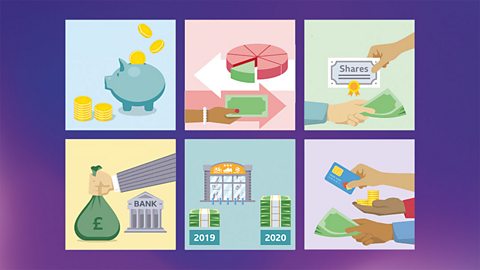Exam techniques
Exam techniques - OCR
Learn techniques for taking your GCSE Business exam with example questions, answers and case studies using the PINCC method.

Business activity, marketing and people
The role of business enterprise and entrepreneurship - OCR
Entrepreneurs spot opportunities and gaps in the market. They will develop new ideas for products and services by combining the resources available to them.

Business planning - OCR
A business plan is an essential part of starting any business. Entrepreneurs create business plans to help them consider all of the elements they are going to need for their new business to be a success.

Business ownership - OCR
There are a number of different ownership options when setting up or running a business. These may depend on the size of the business, the number of owners and the level of risk owners are willing to take.

Business aims and objectives - OCR
All businesses create aims and objectives to give them goals or targets to achieve. Businesses usually have a mixture of financial and non-financial objectives.

Stakeholders in business - OCR
Businesses need to be aware of their stakeholders. The activities of a business will affect many of their stakeholders. The stakeholders can also influence the decisions that a business makes.

Business growth - OCR
Business growth is important as it enables businesses to increase the scale of their operation and competitiveness. This may be done either internally (organically) or externally (inorganically).

The role of marketing, market research and market segmentation - OCR
The aim of marketing is to meet or exceed customer needs and expectations. To do this a business must find out what their customers’ needs are.

The marketing mix - OCR
Together the different elements of the marketing mix can be used to create the image that a business believes will give it the best chance of selling products and services to consumers.

Human resources and organisational structures - OCR
Businesses have many different roles and responsibilities and need staff to carry them out. The role of human resources is to identify the needs of the business and ensure that they are met.

Communications in business - OCR
Businesses make use of various types and methods of communication as part of their day-to-day activities. Using communication effectively can have a significant impact on the success of a business.

Recruitment in business - OCR
New staff may be needed for a number of reasons, but when recruiting a business must decide where to advertise their vacancy, complete relevant documentation, and comply with employment law.

Motivation and retention - OCR
Motivation determines how hard employees are willing to work for a business and how productive a business is. A business can motivate its employees through financial and non-financial methods.

Training and development - OCR
Training and development are important for businesses. They help businesses to ensure their employees are able to perform well, reach their potential and stay motivated.

Operations, finance and influences on business
Production processes - OCR
To compete with rival businesses, production costs must be kept low so that products can be priced competitively. The ability to do this is affected by the production processes and technology used.

Quality of goods and services - OCR
Quality is essential to a business’ success. Customers must be happy with the products and services they receive. If they are not, a business is unlikely to gain a good reputation or repeat customers.

The sales process and customer service - OCR
Often, customers value good customer service above many other factors when making purchases. Offering good customer service can help a business stand out, but they must comply with consumer law.

Business location - OCR
Business owners have to consider a number of things when choosing a location for their business. These include what type of business and how close they need to be to their customers, labour, materials and competitors.

Working with suppliers - OCR
Businesses must manage their materials effectively. They have a choice between keeping additional stock or using just-in-time stock control. They are affected by the relationship with their suppliers.

The role of the finance function - OCR
Larger businesses have functional areas with specific roles. The finance function manages a business’ finances and helps with decision-making. This allows businesses to manage in the modern world.

Sources of finance - OCR
Businesses need to consider how to fund their activities when they are starting up and during their day-to-day operations. Various costs need to be covered, such as equipment, stock and paying bills.

Sources of finance - OCR
Businesses need to consider how to fund their activities when they are starting up and during their day-to-day operations. Various costs need to be covered, such as equipment, stock and paying bills.

Break-even - OCR
Break-even is the point at which a business is not making a profit or a loss. Businesses will calculate their break-even point in order to use the information when making decisions.

Cash and cash flow - OCR
The management of cash and cash flow is important as it can prevent a business from failing. Cash flow is the way that money moves in and out of a business and its bank accounts.

Ethical and environmental considerations - OCR
Businesses operate in global markets and are judged on the contribution they make to society. Behaving ethically, without harming the environment, and within economic constraints plays an important role regardless of impact on profits.

The interdependent nature of business - OCR
To operate effectively, all parts of a business must work together. Marketing, operations, finance and human resources areas must be aware of the decisions being made by each other and the impact that these decisions might have.

Links
- External linkExternal link
- External linkExternal link
- External linkExternal link
- External linkExternal link
- SubscriptionSubscription